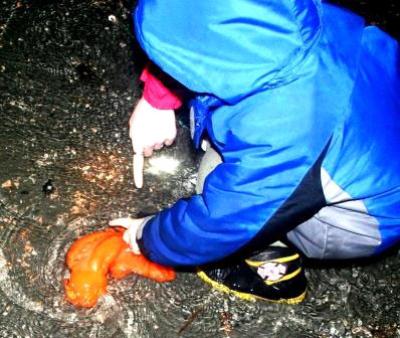
Happy New Year to the Sea Pens

Few of us would think of Vashon when the term "coral" is mentioned, and yet there are several corals that can be found on local shorelines. Of greatest interest to water-gazers waiting for ferries at the north end are the feathery orange sea pens below the dock, which are described as "soft corals" by scientists, rather than the true "stony corals" that build extensive reefs around south Pacific islands. The January 11 Starlight Beach Walk will provide an opportunity to view them up close and hear more about them from Vashon Beach Naturalists, from 9 to 11pm.
A glowing white tent on the beach will provide the starting point of the walk. The nearby pilings are a good first stop, to look for the frilled and striped dogwinkles among barnacles and mussels. Pilings lower on the beach will have sea stars in purple and orange, plumose anemones in white and orange, olive green kelp crabs and small decorator crabs dressed in bits of purple algae. The sea pens will be among the denizens of the deepest end under the dock, and show up best in at least a foot of water so they can wave upright in the water like orange ostrich plumes.
The beds of eelgrass northwest of the dock conceal large red rock crabs beneath their waving blades, which are themselves the homes of small snails, brooding anemones, and crabs. . Walk further yet and you will find a stretch of stony beach, where large rocks hide dramatic red sea cucumbers, bizarre species of worms, interesting fish such as crescent gunnels and clingfish, beautiful porcelain and black-clawed crabs, and other surprises. Because it is dark and cold, these animals will be much less stressed to be discovered by us than they would be during a daylight warm low tide visit. We will be able to peer closely at them and snap their pictures without causing harm. There will be chitons and little pixie hat limpets clinging to the big rocks, and embedded in the areas of fine clay we may encounter the curious-looking piddock, whose shell is customized with spiny ridges for boring its home deep into the clay.
Still, it is the sea pen that intrigues many of us, in part because so many of us have never before seen them and find we enjoy their grace and beauty. One reason they are seldom seen is that they live below the part of the beach exposed by average low tides, and range as deep as 500 feet. Adults can grow to two feet tall, with another six to twelve inches of stem down in the sand. But they regularly contract between feedings or when disturbed by a predator, and can even disappear entirely below the sand. A sea pen can also fully inflate, pull up its foot, and orient itself to the current such that it can drift away from a predator and find a new site. Each pen is a whole colony of little polyps, with three kinds of adaptations. The pen starts when one larva settles onto the bottom sediment and begins to grow its foot below the sediment surface and its stalk above. Then it develops two other types of polyps, the ones that pump water throughout the pen, called siphonozooids, and the ones that feed, called gastrozooids. The gastrozooids have eight tentacles around their mouths, which form the feathery edges of the pen’s plume. These filter tiny organisms out of the water for food.
According to researcher Ronald Shimek, some areas of Puget Sound have enormous beds of sea pens that extend more than a dozen miles along shorelines, only interrupted by manmade features and such natural barriers as river mouths. He speculates that they may be so numerous as to play an ecological role on the sea floor similar to that of the bison herds on the pre-European Great Plains. Among their predators are many nudibranchs, including the Armina californica, the Tritonia festiva and diomedia, Phidiana crassicornis, and Flabellina fusca. Other munchers of the pens include rosy sunstars, vermilion sea stars, leather stars (whose diet averages 98% sea pens), and spiny sea stars (who eat only sea pens). Sea pens keep growing, but rarely survive past 14 or 15 years. The single long, calcareous object within a sea pen’s central shaft, called a style, grows constantly and reflects the pen’s age.
Come out on Friday evening, January 11, and bring family and friends to view the sea pens and all the other picturesque and remarkable plants and animals of Vashon’s north end. This event is co-sponsored by Vashon Beach Naturalists, Vashon Park District, Vashon-Maury Island Audubon, and Vashon College. For more information contact Rayna at 463-3153 or Erin at 463-0303.
- Login to post comments
